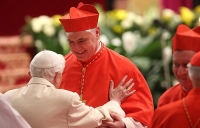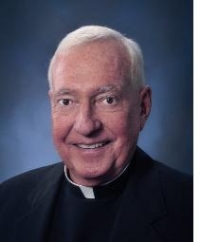Remnant Articles
While Francis perplexes faithful Catholics and delights the world almost daily by saying and doing whatever occurs to him as a good idea, a surprising voice in defense of sound orthodoxy has emerged in the midst of the vast confusion this Pope is causing: Cardinal Gerhard Ludwig Müller, Prefect of the Congregation for the Doctrine of the Faith.
In a book-length interview just published in Spain, Italy, and the United States, Müller has resoundingly reaffirmed his opposition to Cardinal Kasper’s evil proposal to admit a supposedly small number of divorced and “remarried” Catholics to Holy Communion without any commitment to end their adulterous relations. Recall that this blatant attack on the indissolubility of marriage was part of Kasper’s address to the “Extraordinary Consistory on the Family” back in February, and that Francis praised the address as “beautiful and profound.” Recall also that Kasper, with no objection from Francis, is now being identified as “the Pope’s theologian.” Indeed, Francis made it a point to praise Kasper as “a talented theologian, a good theologian” on no less an occasion than his first Angelus address as Pope.
The Remnant recently came across a very telling October 7, 2013 homily by Msgr. Henry A. Kriegel of Saint Patrick Church in Erie, PA.
Since viewing this homily, I've had the misfortune of viewing other talks and homilies from Msgr. Kriegel, proudly posted all over YouTube by Saint Patrick's. During most of these lectures, Msgr. Kriegel presents various erroneous propositions as fact citing no other authority than a vague "consensus of scholars." Nevertheless, the danger here is that unwitting faithful, assisting at Msgr. Kriegel's masses, will accept the authority of their Pastor (who is in "full communion") trusting that he speaks for the Church. In reality nothing can be further from the truth.
Msgr. Kriegel is yet another sad example of a priest with a thoroughly modernist conception of the Church. He is allowed free reign over the poor souls in his parish with the apparent tacit consent of his bishop and the Roman authorities. To do my small part in alerting any parishoners of Msgr. Kriegel's that he is preaching his own doctrine and not that of Christ or the Catholic Church I will take a few statements from Msgr. Kriegel and analyze them below.
Modernism Alive and Well in Diocese of Erie, PA. Here's the Antidote
By: Chris Jackson | Remnant ColumnistRobert’s Dictionary defines the word Freemasonry thus:
"An international Association, in part secret, of a naturalist and philanthropic nature, the members of which recognize one another through certain signs or emblems."
While not being complete, this definition underlines important characteristics of Freemasonry:
- - its ideology: naturalism;
- - its organization: international and secret;
- - its external aspect: often philanthropic;
Before extending the analysis further, let us examine its sources of inspiration, its previous history and some of the main features of its history according to its own historians and others.
Whatever Happened to Christian Society? Freemasonry Happened!
By: Arnaud de LassusThere is a simple tombstone in St. Peter’s Cemetery in West Brighton, Staten Island, New York. It does not stand apart in a specially designated area, nor is it adorned in any way to distinguish this gravesite from the countless others in that consecrated ground. The humble headstone is engraved with the family name Capodanno. Along with his beloved mother and father, this is the final resting place of the mortal remains of a faithful Servant of God who had the valiant, sacrificial heart of a priest, truly another Christ. His name is Father Vincent Robert Capodanno. The inspiring story of Father Capodanno speaks louder than any grand or splendid monument.
The Capodanno Family
Like millions of courageous immigrants before him, Vincent Capodanno, Sr., of Gaeta, Italy, left the security and comfort of his family and homeland in 1901 at the age of sixteen in hopeful anticipation of the American dream. Through perseverance, hard work and faith in God, Vincent established himself in the New World, working as a ship caulker at New York Harbor.
Men of Iron: A Portrait of the Preconciliar Catholic Priest
By: Connie Bagnoli
(Reprinted from The Remnant, July 1995) On July 17, 1794, sixteen holy women were executed by guillotine at the Place du Trône Renversé in Paris. The group comprised thirteen professed Carmelite nuns, one Carmelite novice, and two “tourières” (laywomen servants).
When they were solemnly beatified by Pope Pius X on May 27, 1906, they became the first martyrs under the Masonic “French Revolution” on whom the Holy See passed judgment. Though often called the “Carmelite” martyrs, two of them were not actually Carmelites; they were faithful house servants who considered themselves part of the community and refused to leave them when the Reign of Terror against the Church, the Clergy and all Religious Orders was in full swing.
1) Mother Teresa of St. Augustin [Madeleine Claudine Lidoine] -- prioress -- the last to be executed -- age 42.
2) Mother Henriette of Jesus [Marie-Françoise Gabrielle de Croissy] -- ex-prioress -- age 49.
3) Sister Charlotte of the Resurrection [Anne-Marie-Madeleine Thouret] -- sacristan -- age 79.
4) Sister Of Jesus Crucified [Marie Anne Piedcourt] -- choir-nun -- the eldest -- age 80.
Conservative and Traditional Catholic apologists have spilled a lot of ink over the years explaining how Catholics and Muslims either do or do not worship the same God. Conducting a web search on the topic results in a cavalcade of apologetic websites promising to explain, often in painstaking detail, one or the other side of the issue. Why? Because, of course, a few lines from two documents of Vatican II which refer to Muslims seem to indicate that Catholics and Muslims worship the same God. If you’ll indulge me, I’m going to attempt to cut through the morass created by the repeated attempt to “explain” these few lines by apologists on both sides and simplify this issue to its essentials.
First the “Dogmatic Constitution” (which teaches no new dogma) Lumen Gentium (LG) paragraph sixteen offers the following words regarding the Muslims:
The Pointlessness of the Catholic/ Muslim “Same God” Debate
By: Chris Jackson | Remnant ColumnistThe urgent need of a saintly and courageous Pope to govern and guide the Church in the early years of the ill-fated 20th century is evident from the description of the sad condition of the times that was given by Pope St. Pius X himself in his first Encyclical, E supreme apostolatus Cathedra, in which he wrote that on ascending the Chair of Peter (1903) he was “terrified beyond all else by the disastrous state of human society today.” “Who can fail to see,” he asked, “that at the present time society is suffering more than in any past age from a terrible and radical malady which, while developing every day and gnawing into its very being, is dragging it to destruction. You understand, Venerable Brethren, that this disease is apostasy from God.”
“Truly,” he concluded, “nothing is more allied with ruin, according to the saying of the Prophet (King David): For, behold, they that go away from Thee shall perish (Ps. 72.27).”
Approaching the 100th Anniversary of the Death of the Greatest Pope of the 20th Century
By: Michael J. Matt | EditorIt was Joseph Goebbels, master Nazi propagandist and a trusted confidant of Hitler, who is credited with The Big Lie:
If you tell a lie big enough and keep repeating it people will eventually come to believe it. The lie can be maintained only for such time as the State can shield the people from the political, economic and/or military consequences of the lie. It thus becomes vitally important for the State to use all of its powers to repress dissent, for the truth is the mortal enemy of the lie, and thus by extension, the truth is the greatest enemy of the State.
The Big Lie approach of the Nazis duped the German masses and The Big Lie approach of Modernists has similarly duped many of the faithful, in particular from among the Neo-Catholics. Try this simple substitution for the words of Goebbels:
“[Pope] Benedict did not intend to renounce the munus petrinus, nor the office, or the duties, i.e. which Christ Himself attributed to the Head of the Apostles [Peter] and which has been passed on to his successors. The Pope intended to renounce only the ministerium, which is the exercise and concrete administration of that office.” – Vittorio Messori
There have been some interesting developments in Rome over the past several months, which have brought to light some curious aspects of the Papal resignation of Pope Benedict XVI. The widely read Vittorio Messori – “the most translated Catholic writer in the world” - recently published an article in Corriera della Sera, in which he discusses a newly published study by Stefano Violi, esteemed Professor of Canon Law at the Faculty of Theology in Bologna and Lugano. Professor Violi’s study, which includes a detailed examination of the Latin text of the Papal resignation, argues that Pope Benedict did not intend to completely renounce the Papal office, but only the active exercise thereof. His intent was essentially to split the Papacy in two, thereby transforming the Papal Monarchy into a Papal Diarchy. In Messori’s words:
Reprinted from The Remnant 2004...
The following letter from Dietrich Von Hildebrand, who was described by Pope Pius XII as the 20th century Doctor of the Church, is not without interest in view of the recent critiques appearing in The Remnant of the article "Why Vatican II was Necessary", which appeared in the March 2004 issue of Crisis magazine.
In view of my almost totally negative attitude to the Council set out in my book Pope John’s Council, I felt very uneasy some years ago when reading certain enthusiastic remarks concerning Vatican II in Dietrich Von Hildebrand’s Trojan Horse in the City of God. Compared with Dr. Von Hildebrand I am an intellectual pygmy, and I wrote to him explaining the fact that I was very unhappy about our disagreement, particularly with regard to such instances as his praise for the official documents and "the greatness of the Second Vatican Council" found on page 1 of his book. He replied as follows in a letter, dated 22 April 1976:
Dietrich Von Hildebrand on Vatican II: a 'Great Misfortune'
By: By Michael Davies, RIP(Corrado Gnerre is a philosopher and cooperator with the Franciscan Friars of the Immaculate)
Translated for The Remnant by J. Martin
A typical error of the post-conciliar Church is to not want to be attentive to the reality of things. The Life of Grace falls ... one does nothing. The sense of sin diminishes ... one does nothing. Families are falling apart ... one does nothing. Civil weddings are increasing and in some areas of Italy are more numerous than religious ones ... one does nothing. Young people have forgotten the obligation and the value of premarital chastity ... one does nothing. State laws transposing increasingly dominant ethical relativism ... one does nothing. It's all right, it's useless to worry about it.
A typical error that occurs in two attitudes. The first attitude is a minority which is silent before the wreckage. They are in a sense always appreciative and – in a sense – almost hoping that the trend will continue in this vein. It is – let's face it – the attitude of those Catholics who do not have a clear conscience, with many disorders in private life. In this way they hope to silence their conscience believing that after all the wreckage proves that Catholic morality cannot be fully respected and obeyed, and that it needs to change radically.










